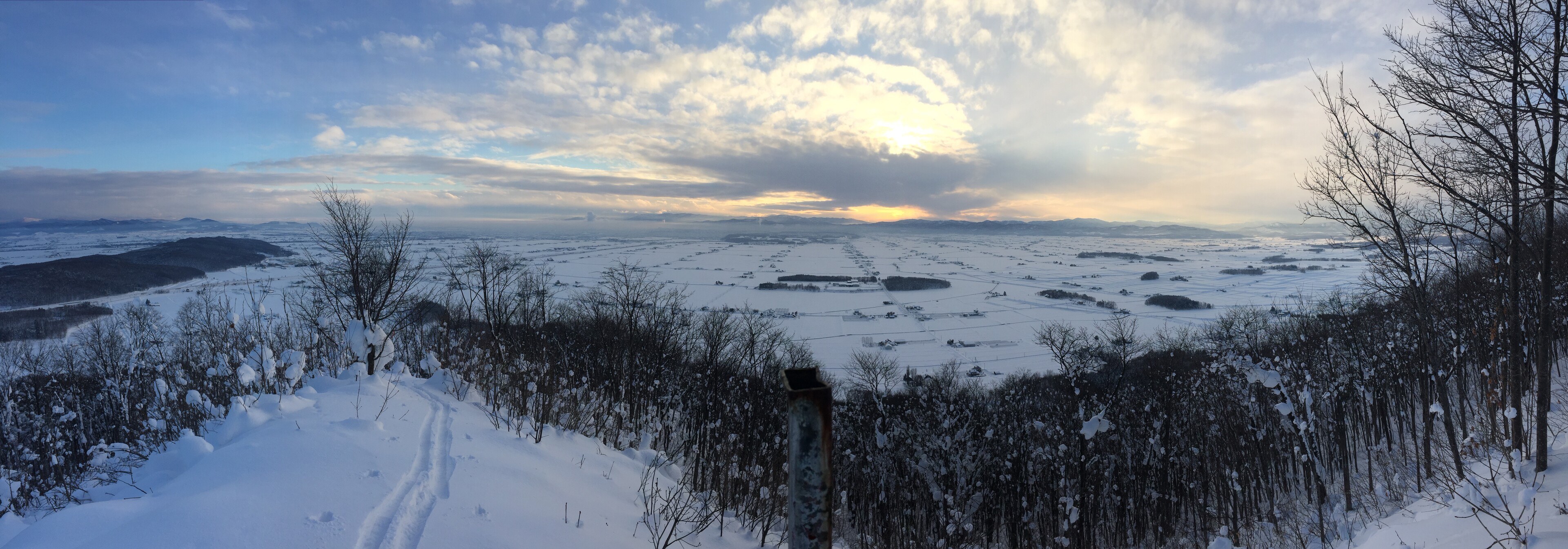Kitoushi-yama (鬼斗牛山)

Sitting around on a Saturday afternoon with little to do, Sam and I decided to head out to Kitoushi-yama (鬼斗牛山, 379 m), a little mountain just north of Asahikawa that we had climbed earlier in the winter. I wanted to see if it was climbable in deeper snow, and I had my new skis and skins with me, so we decided to head over and check it out.
I had thought that Kitoushi-yama was a popular mountain for summer hiking and had considered that it might be locally popular in the winter, but what I didn’t know was that it was/is actually the site of a small ski hill called Higashi-Takasu Ski Field (東鷹栖スキー場). The ski hill sits in a big clear-cut triangular space on the western flanks of the mountain, but there doesn’t appear to be any lifts or lodge or, uh, the trappings of a regular ski hill. I think there might have been something there at some point, but now it’s just a big empty field.
Anyway, we got about halfway to the mountain before we realized that Sam had left her snowshoes behind, but she insisted that I go ahead. The road up to where we left the car last time hadn’t been plowed, so we drove up as close as we could–a little farm-looking place, with a curious pup leashed outside–and Sam dropped me off.
There are three main trails up the mountain, the most popular of which seems to be the “Steep Climb” trail (急登コース)–the same that Sam and I had climbed earlier in the winter. There’s another trail up the southern ridge of the mountain, and a third that climbs up the old ski hill and traverses up the northern ridge. There’s a fourth trail that starts at the same place as the first two and meets the ski hill trail at an overlook called Miharashi-dai (見晴台).
I returned to this trail and found it well worn-in. It looked like people had been climbing here earlier today–and without snowshoes! I couldn’t see any other ski marks, though. Which makes sense, now that I know that one of the trails climbs the ski hill. Whoops.
But so I started to make my way up the steep trail, skinning up alongside the worn-in footprints. The forest was quiet and the shadows were long and trees kept dumping their snow on me any time I brushed up against one. It was pretty tight between the trees but entirely manageable. As I got higher, the slope started to steepen, and it got harder and harder to get good grip with the skis, so I decided to make a bit of a traverse to the trail that climbs the southern ridge–a shallower, longer trail that makes a big loop to the south.
Turns out I was higher up than I thought–halfway across the traverse I looked up and I could see the summit marker maybe 15-20 meters above me. On snowshoes it would have been a pretty straightforward trek straight up with tons of toe crampon action but I decided to keep traversing and climbing. When I made it to the ridge it was just a short climb up a bit of a windblown hump to the summit.
Looks like I had been the first person up the southern ridge trail for a little while, but there was a wealth of footprints coming from the steep trail, the one I’d left. I spent a little time at the summit, took some pictures, and decided to head down.

Heading back down via the steep trail was probably not a super-advisable idea (on skis, anyway), because, true to form, it was pretty steep near the summit and real tight, lots of smaller growth sticking through the snow and getting in the way. After maybe 50 meters or so, it shallowed out and there was a bit of skiing to be done, although I kept having to stop and plan lines so I didn’t wind up wrapped around a tree. Lower down I was finally able to get up some speed as I rejoined the road, and then I was out and phoning Sam to come pick me up.
Trailhead: 15:06 -> summit: 15:41 -> back at trailhead: 15:52
climbing time: 35 minutes / descending time: 11 minutes
Previous
The little-remarked-upon phenomenon of using old disrepaired buses as mobile storage in rural Japan.